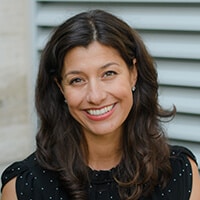Written by Amber Villa-Zang, Faria Education Group
Sherry is a perfect example of the “first follower” at work. Warm, wise, and thoughtful, her first instinct is to deeply understand a process. While in Portland, Rob and Sherry spent a full day setting goals and planning how to move forward with documenting the school’s curriculum. To get the mapping initiative off the ground, Sherry and Rob knew it was critical to introduce it in a way that would resonate with teachers. However, Sherry knew there would be resistance. Prior to the Leadership Institute, she had felt it too. Her plan? To meet this resistance head on. When she returned to school, Sherry composed a “testimonial” where she wrote authentically and honestly about her initial thoughts about documenting the curriculum, as well as how her understanding evolved as she learned more about the process and the benefits of mapping. This included:
- How the process will improve her practice on a personal level, as well as how it will systematically improve teaching and learning at their school.
- An outline of how they will begin the process and how there will be opportunities for individual teachers to lead and learn, based on their experience and comfort level.
- A warm appeal to join this exciting process in a tone that is personal, reflective, respectful, and inviting.
The following is an excerpt of her testimony:
"When I first heard about the idea of Curriculum Mapping I thought to myself “Oh no, here we go again!” How many times over the last 20 years in this system have I sat in a room with my colleagues and wrote down what I thought was our “curriculum”? At least 4x in my memory. And where did all that work and time go? Into some filing cabinet never to be seen again. I thought that this was another government “make-work” project. I have all my courses, units, lesson plans carefully organized in binders and on the u-drive; I do collaborate with my grade 6 team regarding our program in Grade 6; Why do I need to waste my time entering all this information digitally? I am happy to share my stuff with whoever asks.
And then I tried to map my first course onto Atlas. I chose the course that is most current in terms of when I began teaching it (last year) and the course where I am using the most current educational strategies and assessments that I have been reading about, such as inquiry learning and project based learning. I thought, I will just attach all my documents to the map and I will be done. 15 minutes tops! And then I began. Wait a minute…what is the essential question that I want my students to be able to answer after this unit? What enduring understandings do I want them to have after all this discussion and work? What levels of Bloom’s taxonomy am I hitting in this course? What outcomes and standards am I meeting in this course? Pause. Although I do much of this intuitively, after 36 years of teaching I found that I had to go back and rethink this course. I tweaked some lessons, added more meaningful assessments and got rid of some activities that were creative and enjoyable but were not meeting any of the above criteria. I thought: Maybe there is more to this mapping then just data entry.
I was privileged to attend a professional development workshop at the head offices of Atlas in Portland in October. With me were superintendents and consultants and a few teachers from all over the States- large school divisions in New York, Seattle, New Jersey and Portland. All were at different places on the continuum of curriculum mapping, most long after the data entry stage, everyone looking for ways to continue the professional conversation. They told me about incredible collaborations that had occurred along the way. They told me about making time for formal reflective practises that were implemented that enhanced everyone’s experience in education that hugely impacted students, teachers, administrators and parents. They told me about greater connections to outcomes and standards and much higher scores on achievement tests that are mandatory in the states. They told me about creativity and reinvigoration for veteran teachers. They told me about mentoring opportunities for beginning teachers. I was intrigued. I was impressed. I could see the big picture.
We have much to be proud of in this school. We have excellence, a committed staff that goes way beyond for our students every day. But many of us live in silos in this building. Mapping will provide us with the opportunity to break down those walls that isolate us."
Leadership takes many forms. Common qualities include honesty, commitment, a positive attitude, intuition, an effective approach, and the ability to inspire. Sherry’s testimony embodies all of these and much more, as she invites her colleagues to join her to grow and learn together, and to build a legacy for their students.
Pro Tip:
Earning teacher buy-in is a critical first step in any new initiative. Doing so effectively requires a thoughtful approach which considers the unique and collective experiences of your staff. As you begin to think about putting together a game plan for teacher buy-in, think about who your teachers are. Try to empathize with them by understanding their interests, needs, and motivations. Next, be strategic in how to best communicate your message!
Interested in learning more about teacher engagement? Meet the Faculty Bunch!
class="h-full w-full object-cover" src="https://faria.s3.amazonaws.com/Marketing/In-Use/FariaPD/Rebrand+Video-+Teacher+Engagement-+Meet+the+Faculty+Bunch!.mp4" poster="//i.ytimg.com/vi/H1w-ehU4QpM/hqdefault.jpg" controls playsinline >

Amber Villa-ZangFollow @AmberVillaZang
Passionate about pedagogy and the role school leaders and teachers play in creating and providing dynamic, high quality curriculum and instruction, Amber leads professional development sessions for domestic and international school districts. She supports districts in developing standards-aligned curriculum and guides teachers through the process of developing integrated units of instruction. She also collaborates with district curriculum planning teams and leads professional development sessions for differentiated instruction.
Amber graduated from Lewis & Clark College in Portland, Oregon with a bachelor’s degree in English and a master’s degree in Secondary Language Arts. She spent seven years in a public high school teaching a wide range of Language Arts courses, including Senior IB. She also coached volleyball and was active in the school community.

